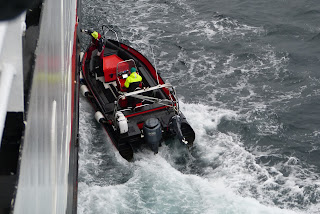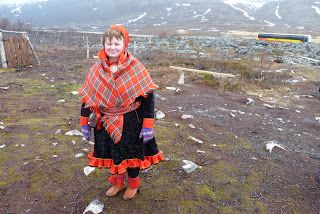Sunday 27th May
Not a good night but we still
missed three ports; the announcement about leaving port at 8:00 woke us.
Just on 10:00 we moored at Kirkenes
the last port before Russia and the turning point of our trip. Kirkenes, like many of the northern Norwegian
towns was used as a base by the Wehrmacht for their offensive against the
ice-free Russian port of Murmansk. The
result, 328 raids by Soviet planes and the total destruction by the retreating Germans
and for two months in the autumn of 1944, 2500 residents sought shelter in a
mining tunnel. Many of the new houses in
the town were paid for by Sweden after the war.
Kirkenes harbour is far up the
fjord and the Gulf Stream doesn’t reach here, consequently the harbour freezes
over in winter. The harbour is also home
to a Russian fishing fleet as there are tax advantages using Kirkenes at their
base.
The main employer is the iron ore
mine which had been closed down for several years but is now being operated by
an Australian company.
Leaving the ship for a two hour
tour of the town and surrounds we drove out to the Russian border before
returning to the ship.
Our next stop was at Vadso, one of
the ports we missed during the night which was home to the NATO early warning
system during the Cold War. We had less
than an hour to walk to the Vardohus Fortress, built in 1737 with most of the
buildings roofed with sod. It was built
to withstand raiders from the east and is the reason the region is still
Norwegian territory. It has never been
touched by war, except for some anti-aircraft fire in 1940 and it only fires
its guns when the whole sun appears above the horizon, usually January 21st
and the towns children are given a day off school.
The fortress has some interesting
displays in its museum including a sled mounted cannon, the first we’ve
seen. The highlight of its display is
the only complete Enigma machine in Norway but it is in a poorly lit glass case
and not well displayed and there aren’t any signs or description.
After dinner we called at two
ports for 15 minutes, not even worth putting on a coat to go out on deck,
though I see through our window that the sun has broken through the cloud for
the first time today at 11:00 pm, we may get to see the midnight sun tonight.
P.S Midnight I have just been on
deck and there is cloud low down but sunlight is visible above it.
Monday 28th May
A very rough night I was woken
around 2:30 am by the corkscrew action of the ship but soon went back to sleep. I hadn’t heard the ship dock at Mehamn
earlier or the next two ports. Some
passengers left the ship at 6:00 to drive to the North Cape and I will be
interested to hear, when they re-join the ship at Hammerfest, if they had any
better weather than our visit.
Hammerfest has always been
regarded as the world’s most northerly town and the weather forecast today
predicted snow and as we were approaching the port we sailed through quite a
heavy fall.
In 1891 Hammerfest was the first
town in Norway to have electric street lighting and its own power generation
and its strategic location made it the choice for the German fleet during the
sea war in the North Atlantic between 1940 and 1944 and the battleships
Scharnhorst and Tirpitz were based in the nearby Altafjord. Like many other towns in the north Hammerfest
was razed by General Rendulic during the German withdrawal.
It is a public holiday today and
all the shops are closed so we walked up to the church to find a baptism
ceremony for many children in progress, we sat for a while to admire the
interior but not wishing to disturb the service left to walk down to the town
square through several snow flurries.
Near where the ship is docked was
the information centre with a display including many of the animals, seals,
birds and a large polar bear together with information about the early days in
Hammerfest. As the weather wasn’t
improving we returned to the ship to get out of the blustery conditions.
After lunch we entered open seas
again for a repeat of the overnight weather, there were many empty seats at
breakfast and it will be interesting to see how many turn up for dinner.
I sat in the stern lounge all
afternoon reading, in fact I read a complete book and wasn’t worried by the
weather but noticed from time to time quite heavy snow falls. When I went to dinner I was advised we were
sailing in a Force 9 gale, which explained why there were so many empty seats
in the dining room. Also during the afternoon
a talk had been cancelled and we didn’t rendezvous with a prawn fisherman to
take on prawns, so that will be an item missing from the menu.
During the gale the Captain
slowed the boat so we were nearly an hour late into Tromso for the midnight concert
at the Arctic Cathedral, not that we knew as we went to bed at 10:30 and slept
through.
Tuesday 29th May
We were up early as we were
leaving on an early tour and we noticed, the same as yesterday, all the
mountains have a fresh cover of snow and as we walked to the bus at Harstad it
started snowing. Harstad has a
population of 27,000 having grown from 30 in the 1870s mainly due to the
herring fishing and when the herring stocks were depleted the town developed
shipbuilding and other industries. Due
to fishing controls the herrings are being caught again but the town doesn’t
have any processing facilities.
Our first stop was at the
medieval church on the Trondenes peninsula built in the 1200s, around 1450 the
church purchased from Northern Germany several altar pieces, most of the money
coming from the parishioner’s contributions in cod and other farm produce which
was sold in Bergen. We were welcomed to
the church by the Pastor who conducted a short ecumenical service in Norwegian
and English and distributed a sheet with the words of a hymn in seven languages
and invited everyone to sing in their own language, a United Nations choir.
We walked a short distance from
the church to a museum which provided information and displays from Viking
times, including a lot of information about the church’s construction as well
as displays featuring the life, activities and housing through the centuries.
Continuing around the island of
Hinnoya we experienced many snow showers while driving past farmlands, there is
more undulating country than we have seen for several days and although the
climate doesn’t allow the growing of fruit or cereals it supports a dairy and
sheep industry. A viable dairy farm is
20 cows and a sheep farmer needs 200 sheep.
Rather than driving around the
sound we took a twenty minute short cut before driving slowly along the edge of
the sound to meet up with the ship at Sortland.
Our next stop was Stokmarknes,
which has been a prosperous trading post since 1776, this town is the home of
the Museum of the Coastal Express and is the town where Richad With founded the
forerunner of the current Hutigruten Line in 1881. The museum contain many displays of cabins,
radio rooms, dining rooms and many artefact from early days of the company together
with models of the many ships and information about the nine ships that were
sunk during WW2.
 Sailing on southwards the new
snow cladding the mountains is very noticeable compared to when we sailed
north, we are still inside the Arctic Circle so I suppose heavy falls in spring
are quite common and the last two days the temperature has ranged between 2 – 5
degrees, I don’t know what it was late in the evening or early morning.
Sailing on southwards the new
snow cladding the mountains is very noticeable compared to when we sailed
north, we are still inside the Arctic Circle so I suppose heavy falls in spring
are quite common and the last two days the temperature has ranged between 2 – 5
degrees, I don’t know what it was late in the evening or early morning.
On our way to Svolvaer we again
sailed into Troll fjord and I thought we were going to have better weather than
during our last visit but as we approached the entrance it began to snow but
eased as we crept our way past the cliffs on either side.
Apart from being the home of trolls
it is famous for the Battle of Troll Fjord which took place in 1880 between
fishermen in steam boats and the sailing boats.
The steam boats were able to monopolise the fishing and the sailing boat
fishermen attacked them in an attempt to share in the catch.
 Arriving at Svolvaer on the
Lofoten Island we left for a quick three hour coach trip around some of the
islands in the group passing the 1200 seat Lofoten Cathedral built in the
1800s, the largest wooden church in the north.
Arriving at Svolvaer on the
Lofoten Island we left for a quick three hour coach trip around some of the
islands in the group passing the 1200 seat Lofoten Cathedral built in the
1800s, the largest wooden church in the north.
Our first stop was as the village
of Henningsvaer where we visited Karl Eric Harr’s art gallery and were treated
to a 20 minutes presentation of photos taken around the islands before viewing
the three floors of painting, mainly of island subjects, scenery, sea and the
people, dating from around 1870 to modern times.
We continued our drive around the
islands, one with a wide valley containing many farms, some small fishing
villages and other areas of rugged inhospitable mountains. The mountains on the island vary from rounded
tops to pointed crags and the height determines the appearance. During the ice age the mountains below the
ice were worn down by the ice and rounded and those above the ice remained
sharp and rugged.
On our travels were haven’t seen
very much wild life but crossing a bridge we were treated to a view of about
100 Eider ducks floating on the fjord.
We reboarded the boat at
Stamsund, not a very attractive village built in the first half of the 1900s
and has one of the island largest fish products plants, a cod live oil factory
and 7 trawlers. We have noticed in many
of the fjords and bays large floating nets about 25 m. in diameter and 10m.
deep, these hold around 20,000 salmon and they are fed pellets which contain
fish meal and vitamins, it take 4 kg of pellets to produce 1 kg of salmon.
We left Stamsund at 10:00 pm and
our next stop is at Bodo at 2:00 am but I don’t think we will wait up to see
it.



























